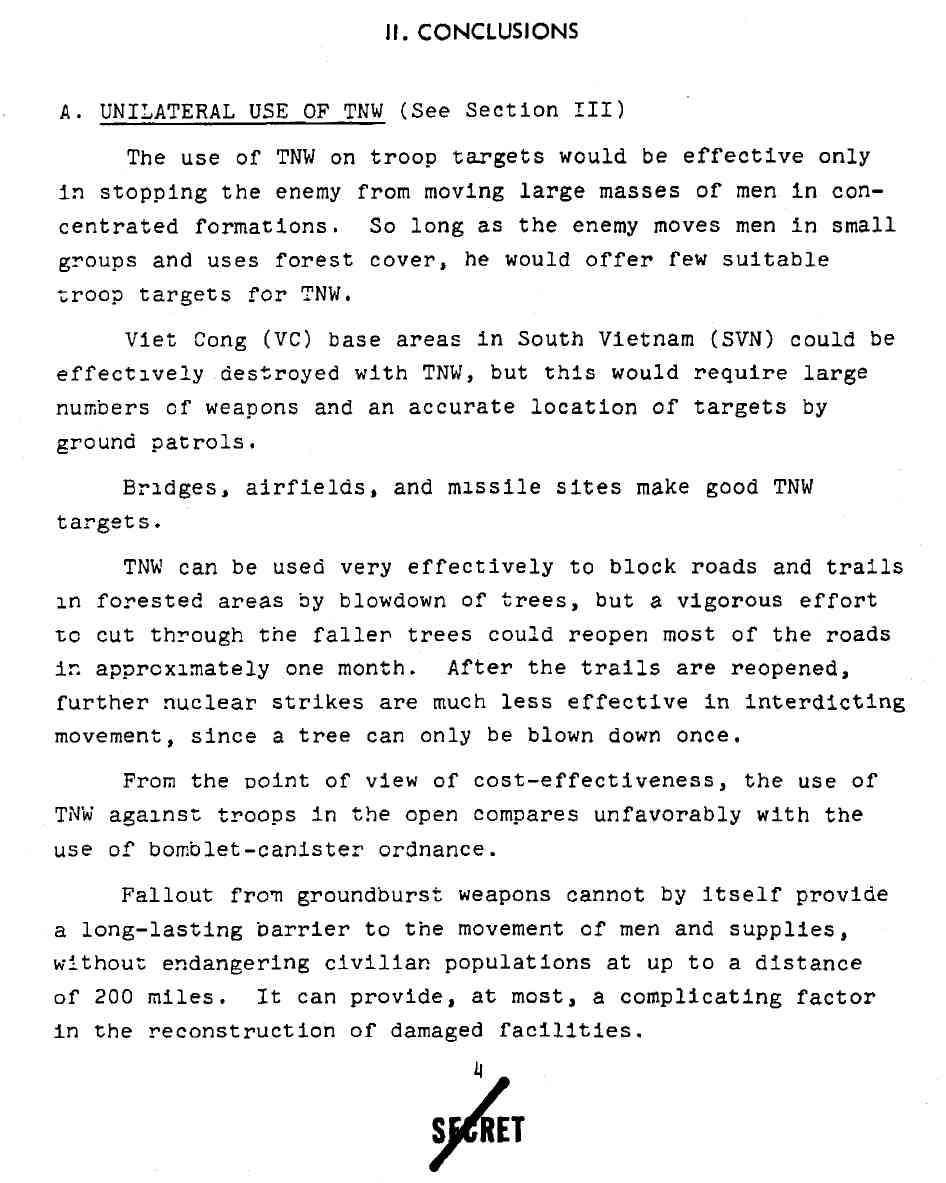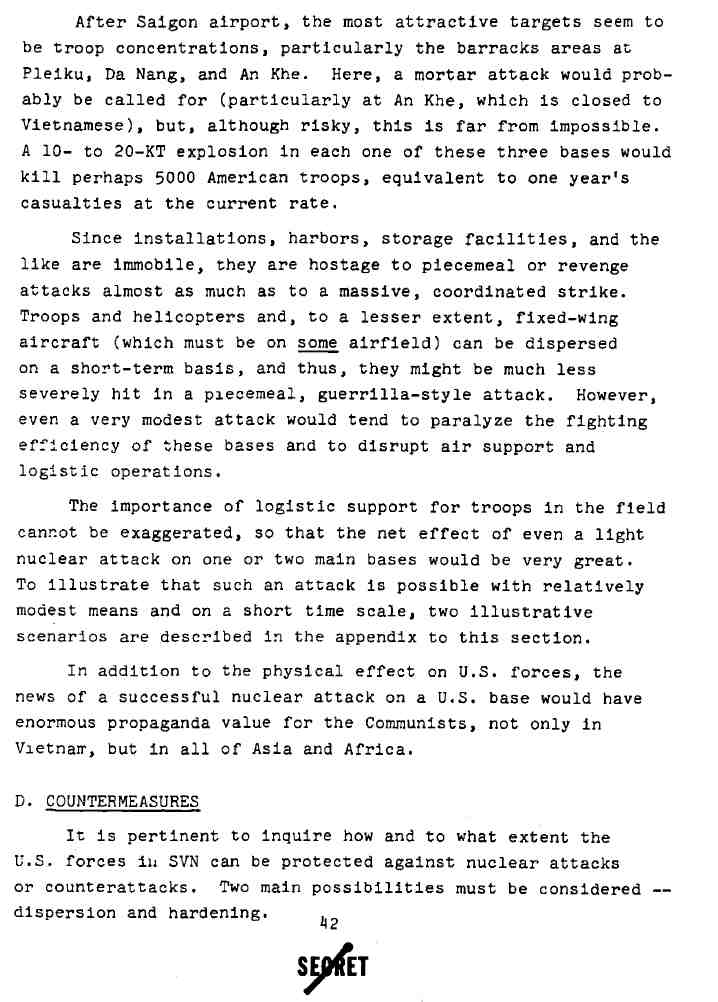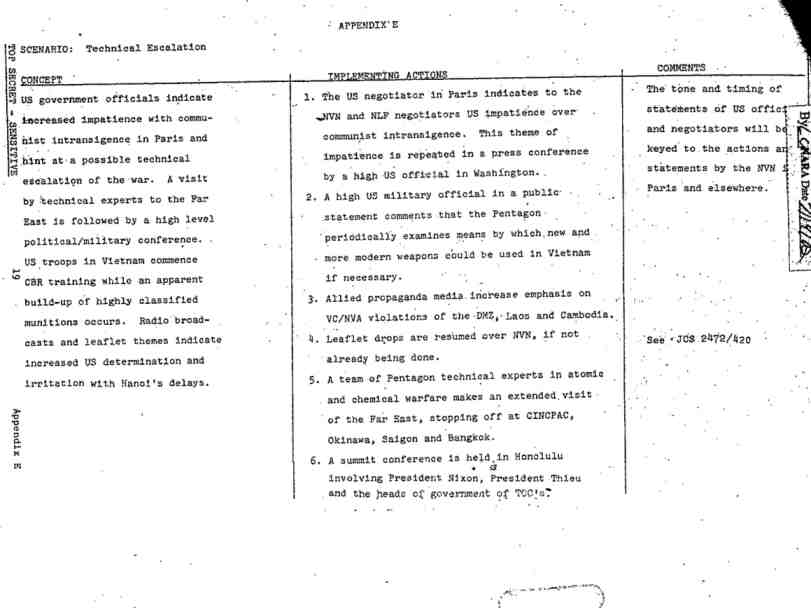|
Vietnam War
Nuclear Weapon Option
Department of Defense, White House, and CIA Files
370 pages of Department of Defense, White House National Security Council, and CIA files that address the nuclear question faced during the Vietnam War
TACTICAL NUCLEAR WEAPONS IN SOUTHEAST ASIA
A 60 page report commissioned by the Department of Defense and completed in March 1967.
The purpose of this study was to evaluate the military consequences of a U.S. decision to use tactical nuclear weapons (TNW) in Southeast Asia, under the assumption that the war remains theater-limited and that no strategic exchange occurs. The study is divided into two main parts. (1) possible targets for U.S. TNW, and effects of nuclear bombardment on the ground war if the use of TNW remains unilateral; and (2) possibility and effectiveness of enemy retaliation with nuclear weapons supplied by the Soviet Union or China. The report provides its conclusions regarding unilateral use of tactical nuclear weapons, the vulnerability of U.S. forces to enemy tactical nuclear weapons, the use of tactical nuclear weapons by insurgents elsewhere and political consequences.
Topics and Sub-topics in the report include:
ADVANTAGES OF TACTICAL NUCLEAR WEAPONS FOR ATTAINMENT OF U.S. MILITARY OBJECTIVES: Catalog of Targets for U.S. Use of Tactical Nuclear Weapons: Troop Concentrations, Headquarters and Communication Centers, Supply Lines, Airfields and SAMS Sites, Mountain Passes and Trails. Characteristics and Effects of TNW on These Targets: Prompt Effects, Delayed Effects, Duration of Fallout Patterns in Maintaining Interdiction of Supply Routes, Continuous-Front Barriers. Examination and Criticism of Relevant War Games. Scenarios for Use of TNW in Escalation of Current Operations in the Vietnam War: Use of TNW Against VC Bases in South Vietnam, Use Against Chinese Troops Moving Through Passes, Use for Long-Term Interdiction of Supply Routes.
THE USE OF NUCLEAR WEAPONS AGAINST U.S. FORCES IN SOUTHEAST ASIA: The U.S. Order of Battle in Vietnam. Means of Delivering TNW. The Effect of Nuclear Attacks on U.S. Forces. Countermeasures. Weapons Requirements Against U.S. Forces in SVN.
EFFECTIVENESS OF TNW IN THE HANDS OF INSURGENTS IN OTHER PARTS OF THE WORLD
POLITICAL CONSEQUENCES: Escalation. Long-Range Consequences.
MCNAMARA PAPERS. STRATEGIC RETALIATORY FORCES. SUBJECT: THEATER NUCLEAR FORCES
147 pages of draft reports, dating from October 1965 to January 15, 1969, from Secretary of Defense Robert McNamara to President Lyndon Johnson, concerning theater nuclear forces. A continuing review of theater nuclear and related chemical and biological forces. Covering nuclear strategy concerning Europe, Asia, the Soviet Union threat, and the China threat.
Included in one of the memorandum to President Johnson is the role of nuclear weapons in Asia. In the drafts can be found discussion of conditions under which nuclear weapons would be used in Asia. Includes comments on under what circumstance the use of Chinese conventional forces in Vietnam might warrant the use of nuclear weapons. One passage on this topic begins with, "In the event that a major Chinese Communist aggression in Southeast Asia indicates that the U.S. might have to face a decision to use nuclear weapons, it is clear that the decision could be taken more deliberately than a similar decision against the Soviet Union in Europe."
Other topics in the drafts include: The Threat to Korea. The Role of Theater Nuclear Weapons in Europe. Nuclear Defense against a Conventional Invasion in the Center Region with Effects Limited to NATO Territory. Nuclear Defense Against Invasion in the Center Region Using Discrete Fire. Mix of Theater Nuclear Forces. The Short Tactical Nuclear Battle. Atomic Demolition Munitions (ADMs). ADMs are nuclear charges designed to delay an advancing army by placing obstacles in its path. The Tactical Nuclear Campaign. The Extended Tactical Nuclear War. Chemical and Biological Warfare Forces. Incapacitating Chemicals (Including Riot Control Agents). The General Nuclear War Problem.
WHITE HOUSE - DUCK HOOK FILES
91 pages of files related to "Duck Hook" plans. National Security Council Files dating from September 29, to October 2, 1974.
When President Richard Nixon took office in January of 1969, a high priority was seeking an end to the Vietnam War in a way that was favorable to the United States. National Security Adviser Henry Kissinger produced a strategy, combining diplomacy and the threat of greater strategic bombing. Henry Kissinger set-up a special NSC staff planning committee referred to as the "September Group," also known as the "contingency group," to evaluate the secret plans prepared by members of the Joint Chiefs of Staff in Washington and military planners in Saigon. The military planners expanded Kissinger's strategy into "Duck Hook".
Duck Hook (code-named "Pruning Knife" by the military) was the White House code-name of an operation President Richard Nixon was given to consider unleashing against North Vietnam during the Vietnam War, if North Vietnam did not yield to Washington's terms at the Paris peace negotiations. Some historians believe Duck Hook called for the possible nuclear bombing of military and economic targets in and around Hanoi, the mining of Haiphong and other ports, air strikes against North Vietnam's northeast line of communications as well as passes and bridges at the Chinese border, and air and ground attacks on other targets throughout Vietnam.
Documents include a September 29, 1969 memorandum from Henry Kissinger aides Roger Morris and Anthony Lake to Captain Rembrandt Robinson of the Joint Chiefs of Staff and the National Security Council's military liaison unit in the White House. Robinson had earlier prepared the Duck Hook plans for attacks on North Vietnam. Lake and Morris criticized the plan saying it should "make it clear that" the September Group believed the President should be prepared to accept two operational concepts: Duck Hook "must be brutal and sustainable" and "self-contained." Regarding the latter requirement, the president would need to decide in advance "the fateful question of how far we will go. He cannot, for example, confront the issue of using tactical nuclear weapons in the midst of the exercise. He must be prepared to play out whatever string necessary in this case." The memo goes on to say that the plan should state, "clearly and fully all the implications of the action, should the President decide to do it."
An attachment to an October 2, 1969 memo from Henry Kissinger to Nixon asked, "Should we be prepared to use nuclear weapons?" The memo warned that "Since we cannot confidently predict the exact point at which Hanoi could be likely to respond positively, we must be prepared to play out whatever string necessary." Kissinger's memo also stated that "To achieve its full effect on Hanoi's thinking, the action must be brutal." ["the action must be brutal" is underlined for emphasis in original document]
The earlier memo from the two Kissinger's aides, Roger Morris and Anthony Lake, stated that the President must be prepared "to decide beforehand, the fateful question of how far we will go. He cannot, for example, confront the issue of using tactical nuclear weapons in the midst of the exercise. He must be prepared to play out whatever string necessary in this case." The identical wording in the Kissinger memo makes some historians believe that Kissinger was referring to the nuclear question when he called for playing out "whatever string necessary."
Files include the outlining of the types of targets in North Vietnam that would be targeted. The outlining of the military concept involving a number of air and naval actions, grouped into intense phases of short duration. "These actions would be markedly different from the previous air and naval operations against NVN," says a report indented for the president.
Included in the files is a draft of an eighteen-page address to be made by President Nixon to the American people on the day Duck Hook was to begin. While no mention of the use of tactical nuclear weapons is made in the speech, the speech points to a course of action over a short period time, meant to cause a great shock to the North. Wording in the speech points to at least near extreme action. This never used speech is believed by some to be a pre-announcement to the American public of the use of tactical nuclear weapons in Vietnam.
A passage in the speech states, "This warning was privately confirmed to Hanoi's chief negotiator in Paris at the beginning of August. He was informed that if no major progress toward a settlement of the war had been made by the first of November, we would be compelled to take measures of the greatest consequence. "But tonight - - after months of the most thorough study and deliberation - - I must report to you that Hanoi has indeed made a tragic miscalculation of our will and purpose. They have not heeded our clear warnings. They have refused to credit the word of the United States." Later in the speech, the wording turns to finality, "That decision had to be my responsibility. It is our common responsibility - - yours and mine - - to demonstrate our unflinching resolve to end this war."
Topics included in these files: Conceptual Plan of Military Operations. Assessment of Military Actions: Conduct Major Air Strikes Against NVN Counter-Air Capability, Mining NVN Ports, Interdiction of the Northeast Rail Line and Air Strikes Against Other Key Targets, Breaching of the Levee System in the Red River Delta. NVN Actions and U.S. Courses of Action: Hanoi's Estimate of U.S. Intentions, Hanoi's Ability to Continue to Receive Outside Economic Aid, Hanoi's Estimate of Internal Political Conditions, Political Objectives to be Gained from Military Operations. Soviet Actions and U.S. Courses of Action. Chinese Communist Actions and U.S. Courses of Action. Integrated Diplomatic and Military Scenarios.
Four days after the Kissinger memo, on October 6, 1969, Nixon decided against Duck Hook.
The reasons for this are believed to be: there were reservations about Duck Hook's potential effectiveness; public support for the war continued to decline; there were signs of political slippage; and Defense Secretary Melvin Laird and Secretary of State William P. Rogers opposed military escalation. Others believe that the goals of Duck Hook, hitting a target once without the need to return for more bombings, a show of force so extreme it would drive the North to negotiate an end to the war with terms favorable to U.S. in an operation lasting only four days would require using tactical nuclear weapons, so the plan was rejected.
At the same time that President Nixon cancelled Duck Hook, it seems that Nixon embarked on a new strategy to start a series of increased nuclear alert measures designed to convey to the Soviets an increasing readiness by U.S. strategic forces. This became known as the "Joint Chiefs of Staff Readiness Test."
JOINT CHIEFS OF STAFF READINESS TEST - DEPARTMENT OF DEFENSE & WHITE HOUSE FILES
60 pages of Department of Defense and White House files covering the Joint Chiefs of Staff Readiness Test.
On October 10, 1969, General Earle Wheeler, the chairman of the Joint Chiefs of Staff, sent a top secret message to American commanders around the world; the order said it had come down from a higher authority to raise their posture to prepare to respond to possible confrontation with the Soviet Union.
In October of 1969 President Richard Nixon ordered the United States Air Force and Navy to engage in exercises to raise their level of nuclear preparedness. This set of maneuvers became known as the Joint Chiefs of Staff Readiness Test. The purpose of this move was to get the Soviet Union's reconnaissance network to notice the moves. Nixon hoped the Soviet Union would then press the North Vietnamese to negotiate an end to the Vietnam War, because of concern the United States was preparing to use nuclear weapons in the conflict.
In his 1978 memoir, Nixon's chief of staff, H.R. Haldeman wrote that President Nixon believed that President Dwight Eisenhower convinced North Korea, China, and the Soviet Union to end the Korean War by issuing a nuclear threat. Haldeman wrote of a conversation with Nixon during the summer of 1968, in which he quotes Nixon as saying, "I call it the Madman Theory, Bob. I want the North Vietnamese to believe that I've reached the point that I might do anything to stop the war. We'll just slip the word to them that 'for God's sake, you know Nixon is obsessed about Communism. We can't restrain him when he is angry, and he has his hand on the nuclear button and Ho Chi Minh himself will be in Paris in two days begging for peace."
In one of the moves taken during the Readiness Test, the Strategic Air Command (SAC) ordered a stand-down of training missions to increase the number of nuclear armed B-52's ready for deployment. On October 27, 1969, SAC ordered eighteen B-52 bombers armed with nuclear weapons to launch from bases in California and the state of Washington, to cross Alaska, were they were refueled in mid-air by KC-135 air tankers, while flying an oval pattern around the polar ice cap toward the Soviet Union and back for eighteen hours.
On October 28, 1969 the order was sent out to end the Readiness Test.
Highlights among the files include: A transcript of a closed meeting between President Nixon and French President Charles de Gaulle, where Nixon mentions the level of influence Nixon believes the Soviets have with the North Vietnamese. A transcript of a closed meeting between President Nixon and Romanian President Nicolae Ceaucescu, where Nixon tells Ceaucescu, who Nixon believed to have some influence with the North Vietnamese, that North Vietnam should not make the grave mistake of not taking his threats seriously. "I don't make idle threats," Nixon told Ceaucescu. A report by the Joint Chiefs of Staff on actions which might jar the North Vietnamese into favorable actions at the Paris peace talks. Included is the option: "A plan for actual or feigned technical escalation of war against the North," followed in parenthesis's "Nuclear." A memorandum from Henry Kissinger to President Richard Nixon dated October 1, 1969, concerning Kissinger's conversation with Soviet Ambassador Dobrynin. Kissinger reports telling Dobrynin that there would be no special treatment for the Soviet Union until Vietnam was solved. "The train had just left the station and was heading down the tracks," Kissinger told Ambassador Dobrynin. A hand-written diary entry by H.R. Haldeman dated Friday October 17. Haldeman wrote that Kissinger told him that he was engaging in signal-type activity around the world to try to jar Soviets and North Vietnam.
CIA FILES
A twelve page March 18, 1966 Central Intelligence Agency, Office of National Estimates report titled, "Use of Nuclear Weapons in the Vietnam War."
"Use of nuclear weapons by the US in the Vietnam War would be on of the most important events of modern history," is the first line of the report.
NIXON SECRET PRESIDENTIAL AUDIO RECORDINGS
A six-hour and six-minute Nixon White House audio tape recorded at the Old Executive Office Building. Included on this tape is an April 25, 1972 exchange between President Nixon and National Security Advisor Henry Kissinger, in which Nixon breaches the subject of the use of nuclear weapons in Vietnam. Although not considered by Nixon scholars to a serious proposal for the use of nuclear weapons, the exchange shows Nixon's frustration with the Vietnam War days before he launched an escalation of the war. "I'd rather use the nuclear bomb," President Nixon told Kissinger. "That, I think, would just be too much," National Security Advisor Kissinger replied. Nixon responded, "The nuclear bomb. Does that bother you?" Later Nixon remarked, "I just want you to think big."
Other subjects mentioned on this tape recorded between April 20 at 3:09 PM and April 25, 1972 at 3:35 PM include public opinion and the Vietnam War, the strategy of increased bombing of North Vietnam, the progress of the war and U.S./Soviet relations. Other participants on this tape include Alexander M. Haig, H. R. Haldeman, Alexander P. Butterfield and Ronald L. Ziegler.
The disc contains a text transcript of all recognizable text embedded into the graphic image of each page of each document, creating a searchable finding aid.
Text searches can be done across all files on the disc
|


